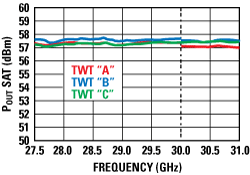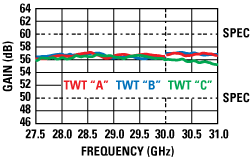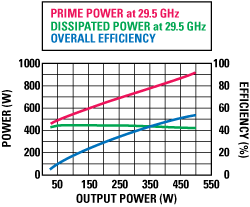
Taking advantage of over 60 years of experience as a global supplier of traveling wave tubes (TWT) and particular expertise in data transmission via satellite, Thales has introduced the new Ka-band TH 4092. This new introduction continues the company's expansion of its range of high-power TWTs to meet the needs of satellite operators around the world and support growing demand for new communication uplinks, including HDTV, direct broadcast TV, consumer broadband and military missions.
The TH 4092 is a new-generation Ka-band TWT dedicated to large earth-station uplink applications in the millimeter-wave bandwidth. Designed for broadband applications at 27.5 to 31 GHz, this powerful TWT delivers 500 W minimum peak power and 350 W in CW operation, covering market requirements for SATCOM uplinks with enhanced data rates and more available linear power. By leveraging the company's experience in spaceborne TWTs, it increases design margins, using a top-down approach that ensures high reliability.

Design characteristics
The TH 4092 is a conduction-cooled TWT for fast mounting. It is equipped with a four-stage collector, drawing on proven space technologies, for high efficiency and low power dissipation. It is housed in a very rugged, compact package (370 × 72 × 60 mm) weighing only about 3 kg.
It is designed to deliver typical RF output power of 550 W CW, providing sufficient margins under specified operating conditions. The design focused on RF characteristics and the thermal qualities of the new subassemblies. Several prototypes underwent duration and environmental tests, which, combined with computer simulations, demonstrated that the maximum temperature and stress levels remain well below critical limits at the various operating points.
The electrical design of the gun and collector meet standards applied to space TWTs for high-voltage insulation: 'cold' electrodes and a low-power electrical field avoid high voltage arcing and spurious switch-off. The gun is equipped with an anode A0; the adjustment of anode A0 and cathode voltages optimize the tube's electrical and RF performance (linearity, RF output power and gain). A beam forming electrode (BFE) handles beam switch-on/switch-off. The BFE voltage (with respect to cathode voltage) is 0 V beam-on and typically -1,400 V beam-off. This fast switching mode is very safe for such a powerful Ka-band TWT.

Figure 1 RF saturated output power.

Figure 2 Small-signal gain.
A positive ion barrier, A1, protects the cathode and increases tube lifetime, while a new helix-rod layout is used to increase beam efficiency and ensure stable operation.
The standard WR34 flange is used for the RF input and output to guarantee higher RF peak power margin and better thermal dissipation. Inputs and outputs are matched to achieve VSWR lower than 1.5:1 in a wide frequency band (26 to 32 GHz). The housing is designed to comply with outdoor environmental conditions, electromagnetic compatibility and low magnetic susceptibility requirements.
Performance
The typical performance characteristics are given in Table 1. Due to the adjustable cathode and anode voltages, RF performance can be optimized for each frequency band, or it can operate over the entire frequency band (27.5 to 31 GHz) with the same voltages. Saturated output power, gain for 350 W rated output power and small-signal gain responses are flat over the full bandwidth, as shown in Figures 1 and 2 for saturated output power and small-signal gain.

Figure 3 Overall efficiency vs. frequency.

Figure 4 Prime power, dissipated power and overall efficiency vs. RF output power.
The advantage of the four-stage collector is that it reaches typical overall efficiency of 55 percent at saturation and 45 percent at 350 W output power (as shown in Figure 3). The dissipated power is lower than 460 W and very constant across the full range of RF output power (see Figure 4). Operating at constant dissipation means less thermal stress for the HPA and increased reliability. Even with its high RF output power, the TH 4092 reflects the 'green HPA' concept.
The TH 4092 combines high RF power with high linearity due to a low phase shift over the whole frequency range (as shown in Figure 5). The IM3 product is higher than 30 dBc for two carriers at 10 dB operating in back-off (OBO). Moreover, the smooth AM/AM and AM/PM characteristics support easy linearizer integration for optimum link performance.

Figure 5 Phase shift and gain compression vs. drive at different frequencies.
The tube's very good linear characteristics offer broad possibilities of adjusting TWT parameters to achieve the best compromise between linear performance and prime power consumption. Moreover, the four collector voltages have been optimized to avoid reflected electrons and thus maintain good linearity up to saturation, a very important characteristic in multicarrier operations.
Qualified for service
The TH 4092 is now fully qualified, with proven state-of-the-art RF characteristics: noise density, phase and output power sensitivities, NPR, EMC, spectral regrowth, etc. Mechanically it has been qualified for random vibrations (10 to 2,000 Hz at 5 g rms) and shock (30 g /11 ms), and operation over a wide baseplate temperature range (-40° to +95°C) has been validated. The variation in gain versus temperature is low (<0.015 dB/°C in linear operation and <0.01 dB/°C for 350 W rated output power). The TWT's compatibility with hot, humid environments (humidity 95 percent, temperature 50°C) and altitude (up to 15,000 m) has also been validated.
Margins and reliability
The technological choices and design margins on the TH 4092 are compatible with an expected lifetime exceeding 50,000 hours. Thales has carried out a margin test program (using an approach similar to its space TWTs) to underpin confidence in year-long 24 × 7 operation.
On a high-power TWT, thermal management and stability are the keys to good reliability. Therefore, all components in the TH 4092 are designed to operate at 500 W CW RF output power. Each subassembly has undergone margin tests; for example, the collector has been validated at 1 kW dissipated power (i.e., twice the nominal value).
Operation at output power higher than 500 W CW has been successfully tested. The low variation in output power after RF switch-on (< 0.1 dB for 550 W CW) demonstrates the high thermal capability of the delay line. The RF power transient record proves that the helix temperature is well below the maximum allowed threshold. This ensures excellent margins for operation at 350 W CW under all specified environmental conditions.
The TWT's stability has been checked for saturated output power higher than 550 W over the full temperature range, with highly variable helix voltage and cathode current values. The low, constant power dissipation versus output power does, in fact, decrease thermal stress in the HPA, thus increasing subsystem reliability.
The gun is designed for an operating life exceeding 50,000 hours, based on an MM type cathode, an adjustable anode A0 and an ion barrier A1. The MM cathode lifetime is space-qualified, with durations longer than 80,000 hours. Use of the adjustable anode A0 provides broad flexibility in achieving the optimum tradeoff between power and linearity, and also enables stabilization of the cathode current and the maintenance of constant performance (power, gain, etc.) over the TWT's lifetime. Also, the ion barrier avoids any ion bombardment that could damage the emitting cathode surface.
Conclusion
The extensive qualification and margin tests performed on the new-generation Ka-band TH 4092 TWT, at 500 W peak/350 W CW, have confirmed the validity of the design choices and technologies used to ensure high reliability. Based on the thermal and stability margins, along with tests on the subassemblies, Thales ensures a service life exceeding 50,000 hours.
Thales Electron Devices,
Paris, France,
Tel: +33 (0)1 30 70 36 40,
www.thalesgroup.com
RS No. 301
